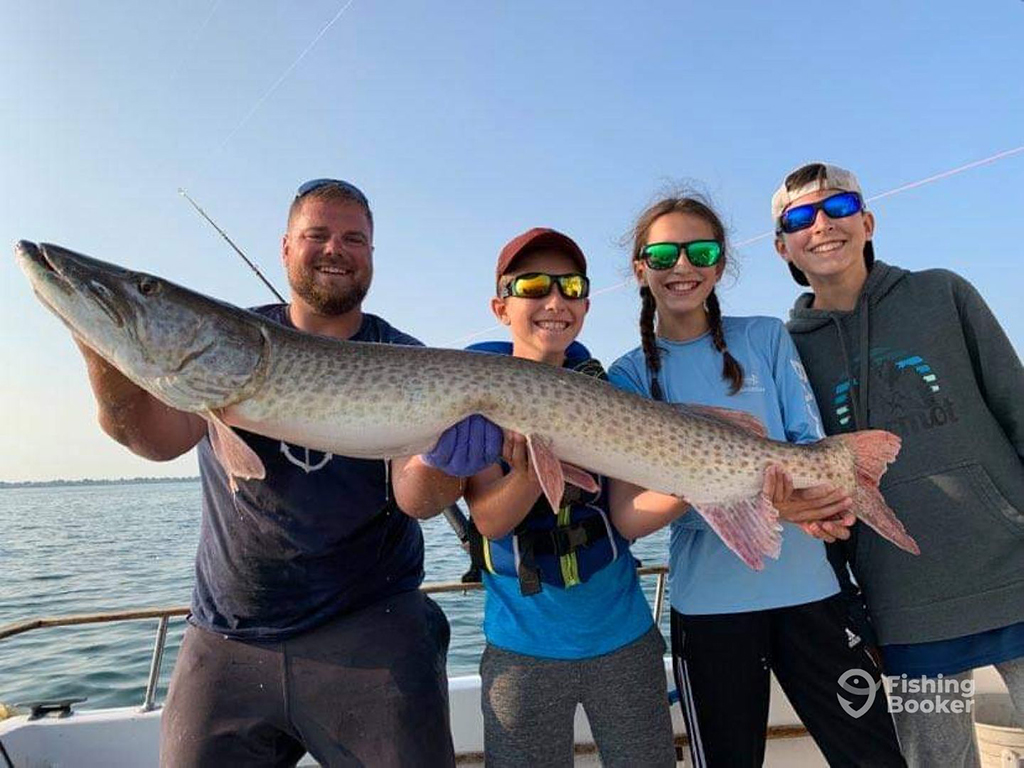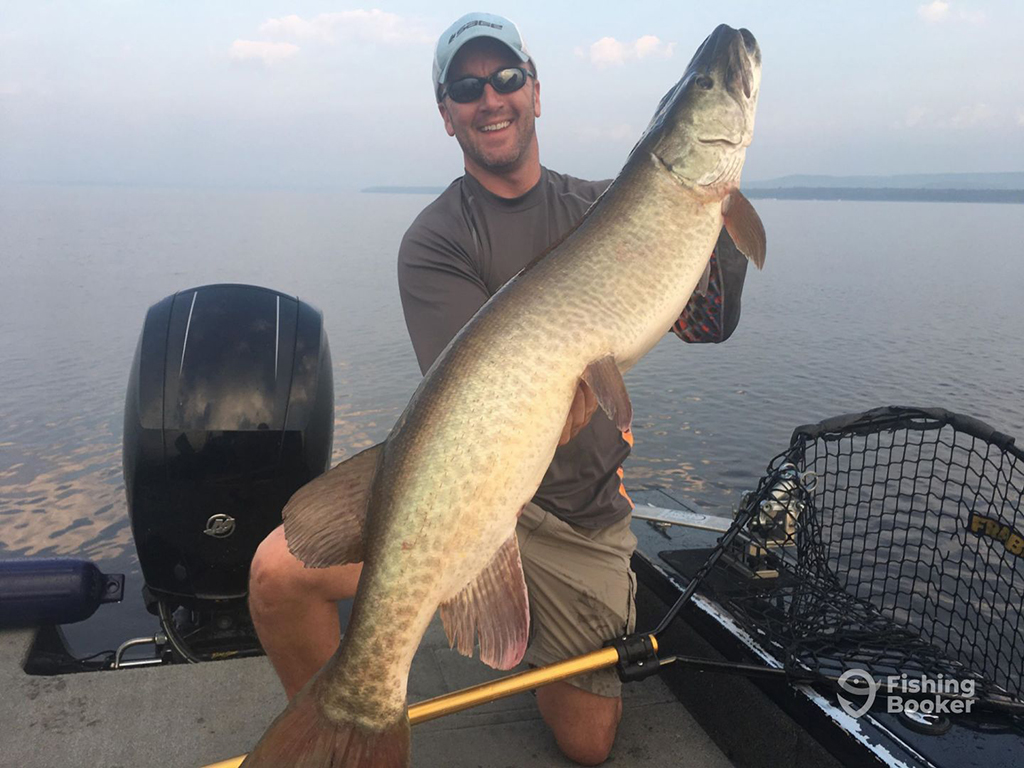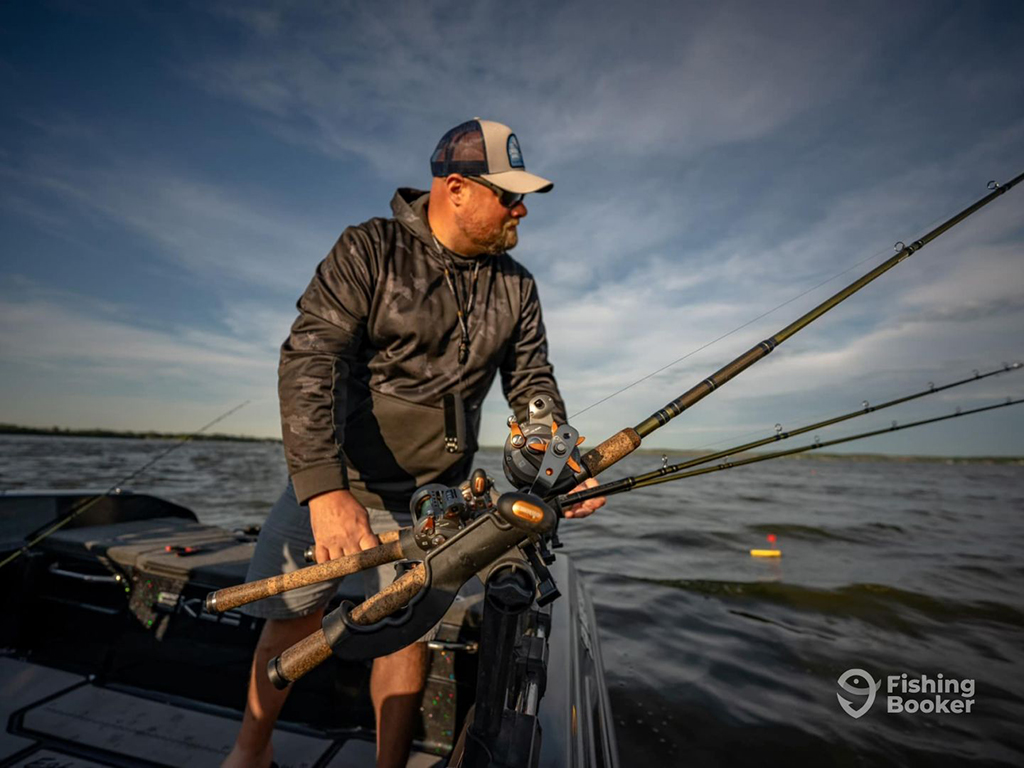Reading Time: 7 minutes
If you’re looking to test your skills and strength against a tough fish, look no further than Musky. These guys are feisty and are sure to get your heart racing when you come across one. And, with a fish this impressive, there’s a lot to learn before getting your hands on one.

Photo courtesy of Mainstream Fishing Charters – 26′
If you’ve caught a Musky before then you know how unpredictable they can be. But if you’re a beginner, you’ll definitely find this guide useful. I’m here today to talk you through the ins and outs of Musky fishing. From identifying the fish to the best gear, times, spots, and more… you get the picture. Let’s dive in!
All About Musky

Photo courtesy of Marc Thorpe Walleye and Musky Guide
Officially known as “Muskellunge,” Muskies are long-bodied freshwater creatures that can reach lengths up to 6 feet and weigh upwards of 60 pounds. They resemble Pike and Alligator Gar, but a few features set them apart…
The first thing you’ll notice is their appearance. Muskies have a brownish shade that’s complimented with a dark, vertical stripe-like patterning. Their fins are on the smaller side compared to Pike, and they also have a pointed fork tail. Even though their fins may be a bit smaller, their mouths are a little larger and they actually grow larger than Pike in general.
These creatures are very powerful due to their strong muscles and good defensive skills. They’re predators at heart. Therefore, they’re naturally aggressive. They aren’t afraid to lunge on any prey, and catching up to their meal isn’t a problem as they can reach great speeds.
When you fight one of these guys, you’re in for a real treat. They’ll run, thrash, jump, pull your rod down, and make your drag scream. And they’re even feisty when you get your hands on them! But if you’re willing to go up against the obstacles, the reward of a big Musky is even greater.
Where can I find Musky?

Photo courtesy of Hot Take Angling
Musky generally inhabit the northern US, as well as spots across Canada. They’re fans of cooler temperatures, so colder states with plenty of fresh water are the most productive areas.
A few popular hotspots where Musky fishing is excellent include the Great Lakes, Chautauqua Lake, the St. Lawrence River, Windmill Point, Fox River, and plenty more. With a bunch of large freshwater bodies in the northern US, there’s plenty of room for Muskies to exist. But it’s helpful to know the best spots so you know where you can find them.
When it comes to habitats where you can expect to find Muskies, look for lakes, rivers, ponds, and canals. The ideal habitat involves grassy and rocky bottoms. They like to lurk within long leaves, waiting to ambush prey.
Before spawning, they like to hang around drop-offs and points. Then, when spawning season takes place, they move towards shorelines that have untouched sand, vegetation, or small rocks. Muskies also like to prowl around river mouths where the water is flowing, as more bait is usually present here.
They tend to move around depending on food sources and water temperatures, so you may see certain spots produce better during specific seasons. The main thing to keep in mind is that when it’s warmer out they tend to move to deeper waters to reach the cooler temperatures – and vice versa.
The Best Times to Go Musky Fishing

Photo courtesy of Locked With Lorensen
Musky fishing can be done year-round across the US and Canada, but some months are way more productive than others. Typically, early spring, fall, and winter are the best times of the year.
Why? Well, first of all, Muskies like overcast and cloudy weather. They aren’t fans of anything hot, especially the sun. These conditions are also great because they provide more low light. Plan your fishing trip around early morning or late evening on a cloudy day, and you’ve got excellent conditions.
As mentioned already, Muskies enjoy being around river mouths where the water pushes plenty of bait through. If you can plan a trip when the water is flowing, that will increase your chances of catching some Musky. And, if there’s a storm coming, get out there before it comes. Experienced anglers know that Muskies get fired up right before a storm and therefore are more likely to bite!
Recommended Musky Fishing Gear

Photo courtesy of Tactical Angling
If you’re new to Musky fishing, you may be thinking, “What gear do I need?” There’s no need to worry, as I’m ready to fill you in!
Before you get ready to battle this freshwater beast, you need a good setup. The perfect rod and reel pair for Musky fishing involves a medium-heavy action rod and a 5000 reel. For saltwater anglers like me, think of a Musky as a Tarpon. Big, strong fish need tough gear.
For your line, most Musky anglers recommend going no less than 40 pounds. Many experienced freshwater fishermen even use wire leaders for Musky. I see why! You don’t want that heartbreak when you get a massive Musky on the line only for them to cut it with their teeth! For hook size, 4/0 is a great choice. If you’re using artificial lures, stick to the 0.5 oz sizes.
As Musky are tough fish with sharp teeth, you can always get extra gear like gloves, dehookers, and more to protect yourself and the fish when trying to release them.
Best Musky Baits

Photo courtesy of FishLSC Charters
When fishing for Musky, you’ll discover they’re fond of both live and artificial baits. With a variety of options to choose from, you’ll have plenty of opportunities to catch a Musky’s attention and get one to bite.
For live bait, bluegill, shiners, white suckers, shad, minnows, crappie, crayfish, frogs, and chubs are all great examples. You can catch your own with cast nets or you can purchase some from bait shops.
But don’t worry if you’re all out of luck for live bait because artificial lures work well for Musky fishing too. Bucktails, topwater lures, paddle tails, jig heads, and crankbaits all do the job. Some popular examples include the Whopper Plopper and Musky Mania Jake crankbait.
How to Go Musky Fishing

Photo courtesy of Marc Thorpe Walleye and Musky Guide
So you know which gear and bait to use, but how to go about it? Well, here I’ll let you in on the most important aspects of Musky fishing. Get ready to learn about all the tips and tricks of Musky fishing.
Look for areas with vegetation, structure, drop-off points, or flowing currents. As Muskies like to feed on the bottom, add a sinker to your bait and let it sink to the floor. The lively motions from your bait will attract a nearby Musky that will ambush them to get a tasty meal.
If the fish are in shallower waters, let your bait sit near shorelines, fish beds, or shallow grassy areas. You can use a floater to keep them towards the surface if needed. It’s also best to be patient and let your bait sit for a bit before recasting if you don’t get a bite.
If you’re using artificial lures, the same principles stand. However, you’ll want to work your bait a little differently. While it depends on what type of lure you use, sudden jerks and slow retrieves will catch the attention of a Muskie.
Once you feel that bite, get a good hookset in and then start reeling. You want to be smooth and quick, but careful at the same time. Make sure they don’t get too close to any structure and be sure to keep the line tension balanced, or else you face the risk of the line breaking. When you get the fish to you, just be careful of their teeth. And if you let them go, ensure the release is long enough for the fish to revive well and safely swim away.
Musky Fishing Regulations
The first step in making sure you’re good with Musky regulations is to have a valid freshwater fishing license. You can purchase yours online, on the phone, or in person at tax offices and sporting stores. Check your local Department of Wildlife’s website for more information.
When it comes to keeping your catch, some states allow it while others don’t. But almost always, the states that allow harvesting will have varying rules, too. Again, consult with your state wildlife department’s website to be sure you avoid any fines – and ensure you’re helping protect the fish and their population!
It’s Now Time for You to Land a Beast!

Photo courtesy of Long Line Charters
It’s no secret that Musky fishing is a challenging adventure. But the joy and accomplishing feelings that follow once you successfully get one in is like no other. Head out on your own or team up with a Musky fishing guide – whatever you choose, we’re sure you won’t regret it. And be sure to send us some photos once you get your newest catch!
Share those images with us below! Or, if you have any questions, feel free to reach out too!
The post How to Go Musky Fishing: An Angler’s Guide appeared first on FishingBooker Blog.
https://fishingbooker.com/blog/musky-fishing/
 CampingSurvivalistHuntingFishingExploringHikingPrivacy PolicyTerms And Conditions
CampingSurvivalistHuntingFishingExploringHikingPrivacy PolicyTerms And Conditions
